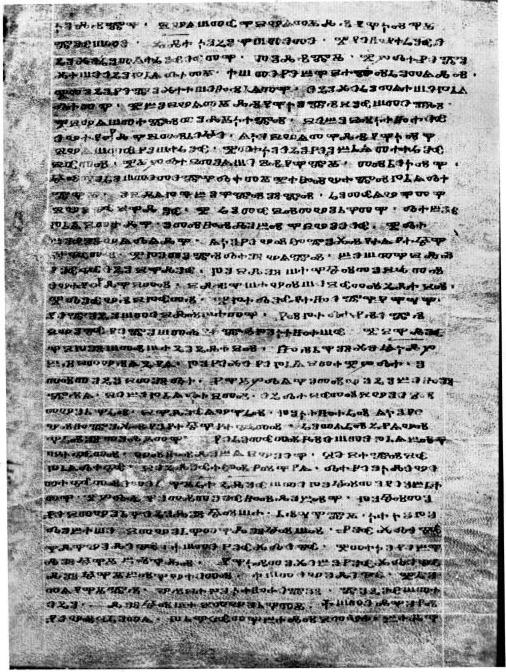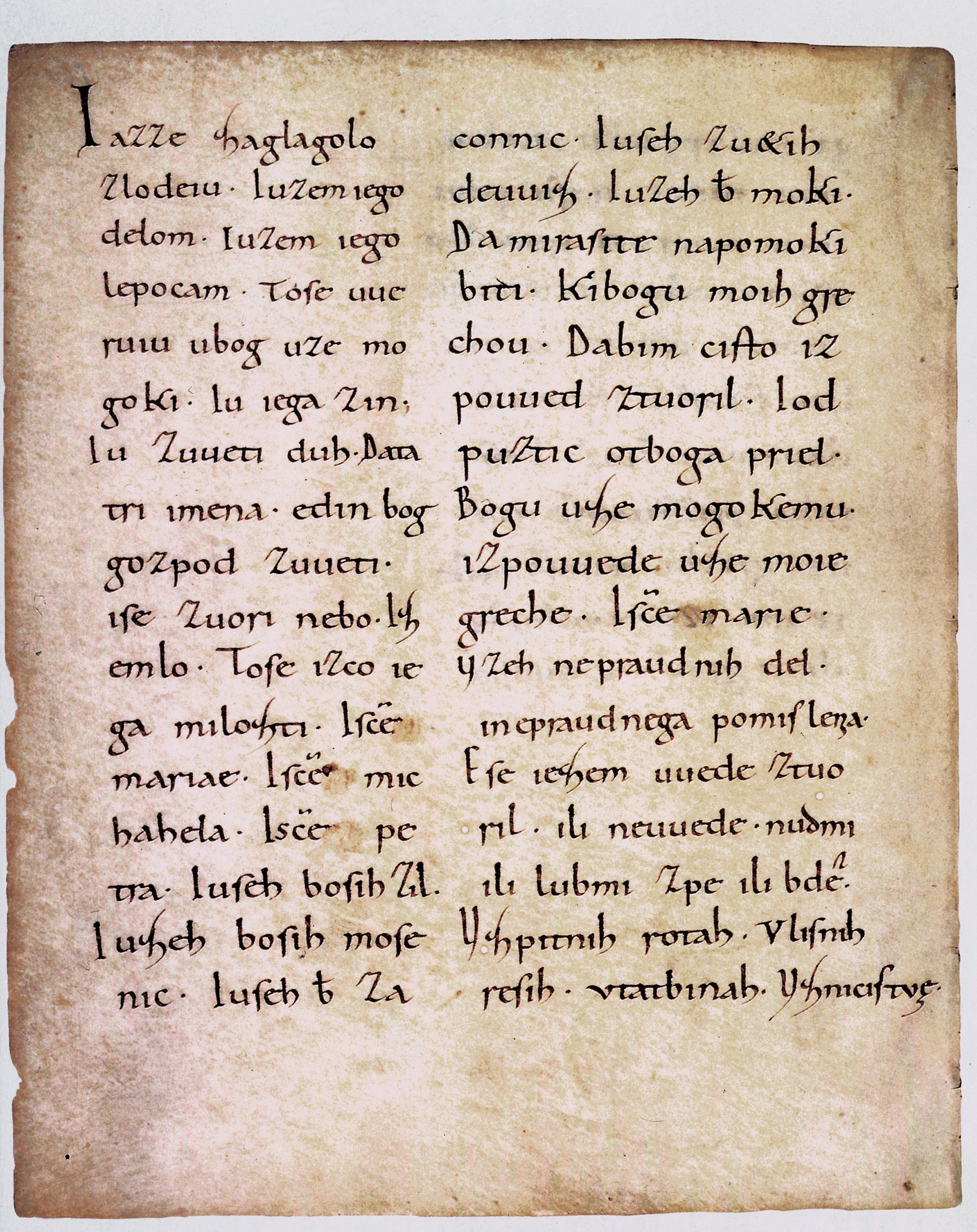|
Glagolita Clozianus
The is a 14-folio Glagolitic Old Church Slavonic canon miscellany, written in the eleventh century. What remained of an originally very large codex, having probably 552 folios (1104 pages), are 14 folios containing five homilies. Two of the homilies are complete; one by John Chrysostom and one by Athanasius of Alexandria, and three of them are fragments, one by John Chrysostom, one by Epiphanius of Salamis and one that is usually attributed to Methodius. Four of those homilies are known from other Old Church Slavonic codices, the exception being the one usually attributed to St. Methodius, which is found only in Clo, and sometimes referred to as the ''Anonymous Homily''. The codex was named after the Count Paris Cloz who owned it in the first half of the 19th century. Prior to that, up until the end of the 15th century, it was owned by the Croatian nobles of the House of Frankopan, who used the codex as a house relic (it was bound with silver and gold) in worship, believing St. ... [...More Info...] [...Related Items...] OR: [Wikipedia] [Google] [Baidu] |
Psalterium Sinaiticum
The Psalterium Sinaiticum (scholarly abbreviations: Psa or Ps. sin.) is a 209-folio Glagolitic Old Church Slavonic canon manuscript, the earliest Slavic psalter, dated to the 11th century. The manuscript was found in Saint Catherine's Monastery in Egypt, after which it was named and where it remains to this day. Discovery The major part of the psalter (177 folios) was discovered in 1850 by the Russian archimandrite Porphyrius Uspensky ( Sin. slav. 38/O), and additional 32 folios with the exact continuation (Ps. 138-150 and the 14 canticles) turned up in 1968 (Sin. slav. 2/N). Editions It was published by L. Geitler (''Psalterium. Glagolski spomenik manastria Siani brda''; Zagreb 1883), S.N. Severjanov (''Sinajskaja psaltyr'. Glagoličeskij pamjatnik XI veka. Prigotovil k pečati Sergej Sever'janov''; Saint Petersburg 1922, transcribed to Cyrillic; reprinted in Graz in 1954) and by Moshe Altbauer in 1971, in a facsimile reproduction (''Sinajski psaltir, glagolski rakopis od ... [...More Info...] [...Related Items...] OR: [Wikipedia] [Google] [Baidu] |
Old Church Slavonic Canon
Old Church Slavonic or Old Slavonic () was the first Slavic literary language. Historians credit the 9th-century Byzantine missionaries Saints Cyril and Methodius with standardizing the language and using it in translating the Bible and other Ancient Greek ecclesiastical texts as part of the Christianization of the Slavs. It is thought to have been based primarily on the dialect of the 9th-century Byzantine Slavs living in the Province of Thessalonica (in present-day Greece). Old Church Slavonic played an important role in the history of the Slavic languages and served as a basis and model for later Church Slavonic traditions, and some Eastern Orthodox and Eastern Catholic churches use this later Church Slavonic as a liturgical language to this day. As the oldest attested Slavic language, OCS provides important evidence for the features of Proto-Slavic, the reconstructed common ancestor of all Slavic languages. Nomenclature The name of the language in Old Church Slavonic ... [...More Info...] [...Related Items...] OR: [Wikipedia] [Google] [Baidu] |
Biblical Manuscripts
A biblical manuscript is any handwritten copy of a portion of the text of the Bible. Biblical manuscripts vary in size from tiny scrolls containing individual verses of the Jewish scriptures (see ''Tefillin'') to huge polyglot codices (multi-lingual books) containing both the Hebrew Bible (Tanakh) and the New Testament, as well as extracanonical works. The study of biblical manuscripts is important because handwritten copies of books can contain errors. Textual criticism attempts to reconstruct the original text of books, especially those published prior to the invention of the printing press. Hebrew Bible (or Tanakh) manuscripts The Aleppo Codex (c. 920 CE) and Leningrad Codex (c. 1008 CE) were once the oldest known manuscripts of the Tanakh in Hebrew. In 1947, the finding of the Dead Sea scrolls at Qumran pushed the manuscript history of the Tanakh back a millennium from such codices. Before this discovery, the earliest extant manuscripts of the Old Testament were in G ... [...More Info...] [...Related Items...] OR: [Wikipedia] [Google] [Baidu] |
11th-century Biblical Manuscripts
The 11th century is the period from 1001 ( MI) through 1100 ( MC) in accordance with the Julian calendar, and the 1st century of the 2nd millennium. In the history of Europe, this period is considered the early part of the High Middle Ages. There was, after a brief ascendancy, a sudden decline of Byzantine power and a rise of Norman domination over much of Europe, along with the prominent role in Europe of notably influential popes. Christendom experienced a formal schism in this century which had been developing over previous centuries between the Latin West and Byzantine East, causing a split in its two largest denominations to this day: Roman Catholicism and Eastern Orthodoxy. In Song dynasty China and the classical Islamic world, this century marked the high point for both classical Chinese civilization, science and technology, and classical Islamic science, philosophy, technology and literature. Rival political factions at the Song dynasty court created strife amon ... [...More Info...] [...Related Items...] OR: [Wikipedia] [Google] [Baidu] |
Google Books
Google Books (previously known as Google Book Search, Google Print, and by its code-name Project Ocean) is a service from Google Inc. that searches the full text of books and magazines that Google has scanned, converted to text using optical character recognition (OCR), and stored in its digital database.The basic Google book link is found at: https://books.google.com/ . The "advanced" interface allowing more specific searches is found at: https://books.google.com/advanced_book_search Books are provided either by publishers and authors through the Google Books Partner Program, or by Google's library partners through the Library Project. Additionally, Google has partnered with a number of magazine publishers to digitize their archives. The Publisher Program was first known as Google Print when it was introduced at the Frankfurt Book Fair in October 2004. The Google Books Library Project, which scans works in the collections of library partners and adds them to the digital invent ... [...More Info...] [...Related Items...] OR: [Wikipedia] [Google] [Baidu] |
Matica Hrvatska
Matica hrvatska ( la, Matrix Croatica) is the oldest independent, non-profit and non-governmental Croatian national institution. It was founded on February 2, 1842 by the Croatian Count Janko Drašković and other prominent members of the Illyrian movement during the Croatian National Revival (1835–1874). Its main goals are to promote Croatian national and cultural identity in the fields of art, science, spiritual creativity, economy and public life as well as to care for social development of Croatia. Today, in the Palace of Matica hrvatska in the centre of Zagreb more than hundred book presentations, scientific symposia, round table discussions, professional and scientific lectures and concerts of classical music are being organized annually. Matica Hrvatska is also one of the largest and most important book and magazine publishers in Croatia. Magazines issued by Matica are ''Vijenac'', ''Hrvatska revija'' and ''Kolo''. Matica Hrvatska also publishes many books in one of its ... [...More Info...] [...Related Items...] OR: [Wikipedia] [Google] [Baidu] |
List Of Glagolitic Manuscripts
This is an incomplete list of manuscripts written in the Glagolitic script. For printed works see List of Glagolitic books. For inscriptions see List of Glagolitic inscriptions. Manuscripts See also * List of Glagolitic books References Literature * Verkholantsev, Julia: ''The Slavic Letters of St. Jerome: The History of Legend and Its. Legacy'', Cornell University Press, Ithaca, New York 2014. * Kolanović, Josip and Obhođaš, Amir: ''Zbirka mikrofilmova glagoljskih rukopisa i isprava'', Zagreb 2006. * Vajs, Josef: Nejstarší breviář charvatsko-hlaholský', Prague 1910. * Vajs, Josef: Rukovet Hlaholske Paleografie.', Prague 1932. * Václav Hanka Václav Hanka (also written as ''Wenceslaus Hanka'') (10 June 1791 – 12 January 1861) was a Czech philologist. Biography Hanka was born at Hořiněves near Hradec Králové. He was sent in 1807 to school at Hradec Králové, to escape the ...: O ostatcích slovanského bohoslužení v Čechách.', Prague 1859. ... [...More Info...] [...Related Items...] OR: [Wikipedia] [Google] [Baidu] |
Antonín Dostál
Antonin, Antonín, and Antoñín are masculine given names. Antonín, a Czech name in use in the Czech Republic, and Antonin, a French name in use in France, and French-speaking countries, are both considered alternate forms of Antonino. Antoñín, a Spanish name in use in Spain and Spanish-speaking countries, is a diminutive form of Antonio. As a surname it is derived from the Antonius root name. Notable people with these names include: Given name: Antonin *Antonin Artaud (1896–1948), French theatre director, writer, actor, and artist *Antonin Bajewski (1915–1941), Polish Franciscan friar *Antonin Baudry (born 1975), French diplomat * Antonin Berruyer (born 1998), French rugby union player *Antonin Berval (1891–1966), French film actor *Antonin Besse (1877–1951), French businessman *Antonin Bobichon (born 1995), French footballer *Antonin Brémond (died 1755), French Master of the Order of Preachers * Antonin Carlès (1851–1919), French sculptor *Antonin Cloche (1628 ... [...More Info...] [...Related Items...] OR: [Wikipedia] [Google] [Baidu] |
Václav Vondrák
Wenzel Vondrák (Czech: ''Václav Vondrák''; September 22, 1859 in Dub – 1925) was a Czech Slavist and professor at the universities of Vienna and Brno. Life From 1872 to 1880, Vondrák attended gymnasium in Prachatice and České Budějovice. He moved to Vienna, starting to study Roman philology, but soon switching to Slavic philology under Franz Miklosich. He obtained a doctoral degree in 1884. From 1881 to 1891, Vondrák worked as a private teacher for various aristocratic families. In 1893, he attained habilitation in Slavic languages and literature in Vienna. In 1903, he was appointed to professor extraordinarius at the Vienna University. In 1919, he was appointed to professor at the Brno University. Vondráks research contributions lie in the fields of Old Church Slavonic Old Church Slavonic or Old Slavonic () was the first Slavic languages, Slavic literary language. Historians credit the 9th-century Byzantine Empire, Byzantine missionaries Saints Cyril and Me ... [...More Info...] [...Related Items...] OR: [Wikipedia] [Google] [Baidu] |
Freising Fragments
The Freising manuscriptsAlso ''Freising folia'', ''Freising fragments'', or ''Freising monuments''; german: Freisinger Denkmäler, la, Monumenta Frisingensia, sl, Brižinski spomeniki or are the first Latin-script continuous text in a Slavic language and the oldest document in Slovene. Description and origin The manuscripts were found bound into a Latin codex (manuscript book). Four parchment leaves and a further quarter of a page have been preserved. They consist of three texts in the oldest Slovene dialect. Linguistic, stylistic and contextual analyses reveal that these are church texts of careful composition and literary form. The precise date of the origin of the Freising Manuscripts cannot be exactly determined; the original text was probably written in the 9th century. In this liturgic and homiletic manuscript, three Slovene records were found and this miscellany was probably an episcopal manual (pontificals). The Freising Manuscripts in it were created between 972 a ... [...More Info...] [...Related Items...] OR: [Wikipedia] [Google] [Baidu] |
Jernej Kopitar
Jernej Kopitar, also known as Bartholomeus Kopitar (21 August 1780 – 11 August 1844), was a Slovene linguist and philologist working in Vienna. He also worked as the Imperial censor for Slovene literature in Vienna. He is perhaps best known for his role in the Serbian language reform started by Vuk Stefanović Karadžić, where he played a vital role in supporting the reform by using his reputation and influence as a Slavic philologist. Early life Kopitar was born in the small Carniolan village of Repnje near Vodice, in what was then the Habsburg monarchy and is now in Slovenia. After graduating from the lyceum in Ljubljana, he became a private teacher in the house of baron Sigmund Zois, a renowned entrepreneur, scientist and patron of arts. Kopitar later became Zois' personal secretary and librarian. During this period, he became acquainted with the circle of Enlightenment intellectuals that gathered in Zois' mansion, such as the playwright and historian Anton Tomaž Lin ... [...More Info...] [...Related Items...] OR: [Wikipedia] [Google] [Baidu] |



.jpg)


